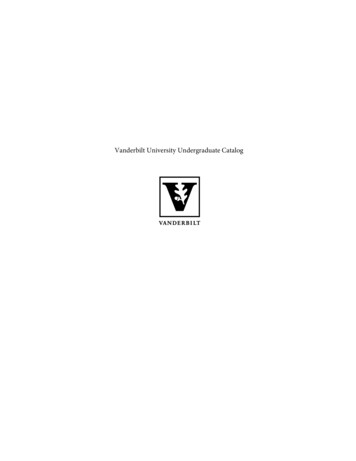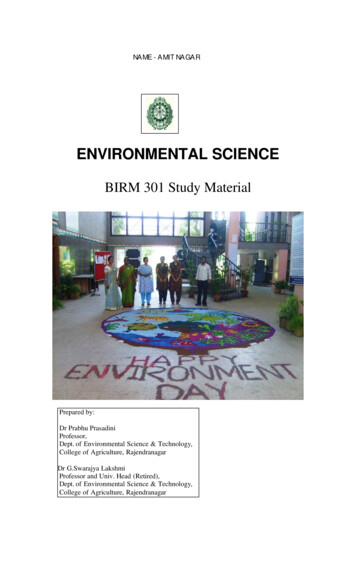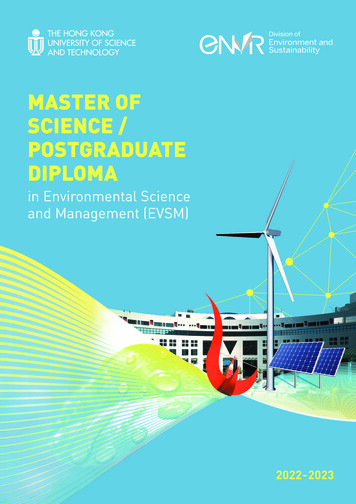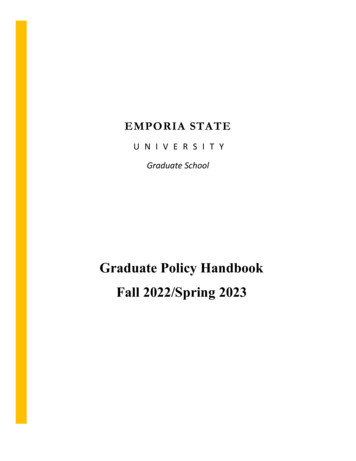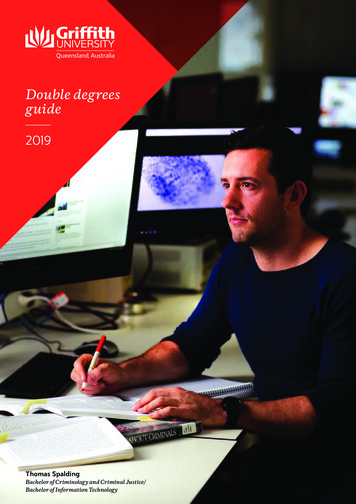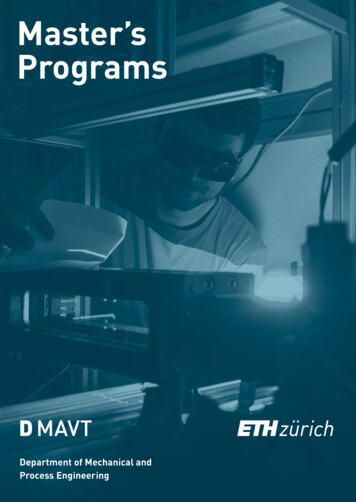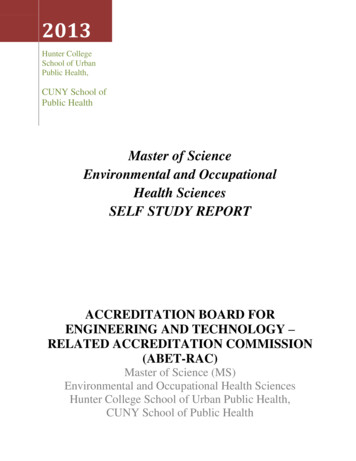
Transcription
2013Hunter CollegeSchool of UrbanPublic Health,CUNY School ofPublic HealthMaster of ScienceEnvironmental and OccupationalHealth SciencesSELF STUDY REPORTACCREDITATION BOARD FORENGINEERING AND TECHNOLOGY –RELATED ACCREDITATION COMMISSION(ABET-RAC)Master of Science (MS)Environmental and Occupational Health SciencesHunter College School of Urban Public Health,CUNY School of Public Health
Table of ContentsBACKGROUND INFORMATION . 1a.b.c.d.e.f.g.Contact information . 1Program History . 1Options . 2Organizational Structure . 2Program Delivery Modes . 2Program Locations . 3Deficiencies, Weaknesses or Concerns. 3CRITERION 1. STUDENTS . 7a.b.c.d.e.f.g.Student Admissions . 7Evaluating Student Performance. 8Transfer Student and Transfer Courses. 9Advising and Career Guidance . 10Work in Lieu of Courses . 11Graduation Requirements . 11Transcripts of Recent Graduates . 12CRITERION 2. PROGRAM EDUCATIONAL OBJECTIVES . 14a.b.c.d.e.Mission Statement . 14Program Educational Objectives . 15Consistency of Program Educational Objectives with Mission of Institution . 15Program Constituencies . 18Process for Review of the Program Educational Objectives . 19CRITERION 3. STUDENT OUTCOMES . 22a. Establishment and Revision of Student Outcomes . 22b. Student Outcomes . 23c. Relationship of Student Outcomes to Program Educational Objectives . 26CRITERION 4. CONTINUOUS IMPROVEMENT . 43a. Student Outcomes . 43b. Continuous Improvement . 49c. Additional Information . 50CRITERION 5. CURRICULUM . 54a. Program Curriculum . 54b. Course Syllabi . 59CRITERION 6. FACULTY . 62i
a.b.c.d.e.Faculty Qualifications . 62Faculty Workload . 65Faculty Size . 66Professional Development . 67Authority and Responsibility of Faculty . 67CRITERION 7. FACILITIES . 71a.b.c.d.e.f.Offices, Classrooms and Laboratories . 71Computing Resources . 72Guidance . 73Maintenance and Upgrading of Facilities. 73Library Services. 74Overall Comments on Facilities . 75CRITERION 8. INSTITUTIONAL SUPPORT . 76a.b.c.d.e.Leadership . 76Program Budget and Financial Support . 77Staffing . 79Faculty Hiring and Retention . 80Support of Faculty Professional development . 81PROGRAM CRITERIA . 82Appendix A – Course Syllabi . 84Appendix B – Faculty Vitae . 112Appendix C – Equipment . 121Appendix D – Institutional Summary. 124Appendix E – 2010 Evaluation Report . 129ii
BACKGROUND INFORMATIONA. Contact InformationInterim Dean Neal L. Cohen, MDSchool of Urban Public Health, Hunter CollegeCity University of New York School of Public Health (CUNY SPH)2180 Third AvenueNew York City, NY 10035(212) 396-7729ncoh@hunter.cuny.eduB. Program HistoryThe City University of New York (CUNY) is the largest and most diverse urban publicuniversity in the United States, consisting of 23 campuses and 250,000 matriculated students.Hunter College is one of 11 senior colleges.The MS degree program in EOHS was one of the original programs established at the HunterCollege Institute of Health Sciences in 1971. The initial focus of the program was two-fold: todevelop specialists in environmental impact assessment and to train teachers seeking careers inenvironmental education. The industrial hygiene and occupational health curriculum was addedin 1978 in response to workforce development needs, arising from the formation of the U.S.Occupational Safety and Health Administration (OSHA). The EOHS-MS program has alsobeen a part of the National Institute for Occupational Safety and Health (NIOSH) – NewYork/New Jersey (NY/NJ) Educational Resource Center (ERC) since the late 1970s andreceives government support to train and develop industrial hygienists. Today the EOHSgraduate program is recognized as a leader in environmental and occupational health educationin the NY/NJ metropolitan area.In 1999, Hunter College combined its programs in Environmental and Occupational HealthSciences, Community Health Education, and Public Health Nutrition into a single program inUrban Public Health (UPH) with three relatively autonomous professional tracks each offeringa Master of Public Health (MPH) degree. For many years, the EOHS program offered twodegrees: the MS and MPH. The EOHS-MPH degree program was accredited by the Council onEducation for Public Health (CEPH) in 2000. The MS curriculum is designed to impartcompetencies in core areas of environmental and occupational hygiene, while the MPHprovides students with broader competencies in environmental health and safety. There aredistinct curricula for each degree program (although students in both programs take somecourses in common).The MS curriculum was revised and approved by the Hunter College Faculty Senate inDecember, 2000 to fulfill the requirements for ABET accreditation. These changes took effectduring the Fall 2001 semester, and the first graduate of the program completed the curriculum1
in Spring 2002. The MS curriculum was further revised and approved by the Hunter CollegeFaculty Senate, effective Fall 2010. The MS program in EOHS was first accredited by ABETin 2001 and reaccredited in 2007.In September of 2006, CUNY Chancellor Matthew Goldstein announced the university’scommitment to develop a collaborative School of Public Health that would include the publichealth programs at Brooklyn, Hunter and Lehman Colleges and the Graduate School andUniversity Center (GC). Hunter was the only campus to house a program in EOHS. In 2007,CUNY received approval from its Board of Trustees and the New York State EducationDepartment to create a Doctor of Public Health (DPH) program, including an Environmentaland Occupational Health Track, jointly offered by Hunter College and the (GC). In 2010,CUNY approved a governance and administrative structure and bylaws that allow the SPH tofunction in its environment. As part of these changes, the Hunter College School of UrbanPublic Health (UPH) was established, as the ‘home’ of the bachelor’s and master’s programs inpublic health at the Hunter Camps. UPH is one of the four consortial campuses within theCUNY SPH. The EOHS Track was renamed the EOHS Program. In the summer of 2011,UPH and its EOHS track moved to a new eight-story, 147,000-square foot green building inEast Harlem, which is shared with the Hunter College School of Social Work.C. Options -Title of Degree and Program Under ASAC-ABET ReviewThe CUNY SPH, and its component School of Urban Public Health (UPH) at Hunter Collegeare seeking reaccreditation by ASAC-ABET of the EOHS-MS.D. Organizational StructureFor the sake of clarity and consistency, we have equated the following organizational termsused by ABET with the appropriate organizations within Hunter College and CUNY:PROGRAM NAMEDEGREEADMINISTRATIVE UNITINSTITUTIONEnvironmental and Occupational Health Sciences (EOHS)Master of Science (MS)Hunter College, City University of New York (CUNY)CUNY School of Public Health (SPH) /School of Urban PublicHealth (SUPH)The organizational structure is depicted in Figure 1a and 1b at the end of this section. TheCUNY SPH is a consortial school, comprised of four campuses. The EOHS-MS and MPHDegree Programs are part of the SUPH of Hunter College. EOHS is one of five programswithin this unit. Each program at Hunter is headed by a Program Director. The ProgramDirector reports to the Campus Director, who in turn, reports to the Dean. The reportingstructure is discussed more fully in Criterion 8.E. Program Delivery Modes2
The MS-EOHS (ABET-IH concentration) degree is offered as a full or part-time course ofstudy. Classes are offered Monday through Thursday in the late afternoon or evening.F. Program LocationsNearly all required and elective classes are held at the Silberman Building, 2180 Third Avenue,New York, NY 10035. Select advanced courses may be held at the Graduate Center (GC).G. Deficiencies, Weaknesses, or Concerns Documented in the Final Report from thePrevious Review and the Actions Taken To Address ThemBased on the 2007 visit and self-study, no institutional deficiencies, weaknesses and concernswere identified. However, one program deficiency, two program weaknesses and one programconcern were identified. These issues and measures taken to address them are described below.Program Deficiency1. Criterion 8, Program Criteria. The ASAC review noted that, “The title of the program mustbe shown on the graduating student’s transcript.”Response:Effective January 2008, corrections were made on transcripts to state “ENV OCCHLTH SCI MS” for graduated students. This change was made retroactively for priorstudents and implemented prospectively. ASAC issued a final statement concluding thatthis deficiency was resolved.Program Weaknesses1. Criterion 1, Students. The ASAC criteria state that “the institution must also have andenforce procedures to assure that all students meet all program requirements”. Reviewers notedthat documentation of satisfaction of entrance requirements was not available at the time of thevisit, and that the required course Supervised Field Studies (EOHS 761) was not on allstudents’ transcripts.Response:The institution provided complete application materials for selected students todocument satisfaction of entrance requirements. Documentation from the Registrarthat students were also provided to show that graduates had completed SupervisedField Studies (EOHS 761) or an equivalent course. The ASAC review concluded thatthis weakness was resolved.2. Criterion 3, Program Outcome and Assessment. The ASAC review noted the need for moreeffective program assessment. Post visit, the institution provided an assessment plan, policiesand procedures, along with an implementation timetable to ABET. Documentation ofprocedures for reviewing student progress (e.g. during faculty meetings), student advisementsessions, student meetings and student course evaluations, minutes from EOHS external3
advisory board meetings, and surveys of graduating students, alumni and employers wereprovided to ABET. These are described in detail in the text for Criterion 4, ContinuousImprovement. The weakness, however, remained until the plan documentation that assessmentfinds are analyzed and used for continuous program improvement are provided to ABET.Program Observation1. Criterion 7, Institutional Support and Financial Resources. The ABET review noted concernsthat faculty salaries are well below faculty salaries at comparable programs and nationalaverages for the industrial hygiene field in the face of higher cost of living in the New YorkCity area, and that several faculty were at or beyond normal retirement age.The current state of the faculty is addressed in Criterion 6, and institutional program support inCriterion 7.4
Figure 1a - BackgroundAdministrative Structure of CUNY School of Public Health5
Figure 1b - BackgroundSchool of Public Health Degree Programs by Specialization and Campus6
CRITERION 1. STUDENTSA. Student AdmissionsSummarize the requirements and process for accepting new students into the program.As adopted in a resolution by the Hunter College Senate in May 2001, and after review andsupport by the various Schools, Division and College-wide Curriculum committees, studentsadmitted to the EOHS MS-degree program are required to have completed a B.A. or B.S.degree or its equivalent from an accredited U.S. college or university. (Academic credentialsfrom non-U.S. institutions are evaluated by the Hunter College Office of Admissions in orderto establish an equivalency to a U.S. baccalaureate degree.)Applicants are evaluated according to the following guidelines: An undergraduate grade point average of B or better in their major and an overallundergraduate grade point average of B- or better. Proof of verbal, quantitative and written GRE scores or a previously-earned Master’sdegree from an accredited U.S. college or university. At least 40 credits of undergraduate or graduate-level basic science and mathematicsthrough one semester of calculus and statistics. Generally, an undergraduate biology,chemistry, environmental sciences or physics major would satisfy these requirements. If from a non-English-speaking country, the Test of English as a Foreign Language(TOEFL) examination with a score of 550 or better on the paper-based test or 213 on thecomputer-based test. Two satisfactory letters of reference from persons who have known the applicant in anacademic or professional supervisory capacity.Admissions review is implemented in accordance with the procedure established by SUPH andCUNY SPH for timely application review and reporting of decisions. At the creation of theSPH, the EOHS program (as all programs at the SPH) moved to a single fall semesteracceptance system. This application and admissions process was greatly simplified with theadoption of “Hobson’s WebApply” a web-based application and admissions review programthat digitizes all application data including letters of reference and all college transcripts.The review process begins with notification from the Office of Graduate Admissions thatapplicants are “ready to be reviewed” The specific admissions review process at EOHS consistsof:a) Each EOHS faculty logs into “WebApply” and reviews each application (includingletters of reference, admission essay, and all college transcripts.b) The faculty member enters online notes for each applicant and makes arecommendation (admit unconditionally, admit with conditions, hold, non-degreeadmission or reject)7
c) The Program Director reviews each review for each student and enters the finaldetermination.d) If the recommendations of two faculty members regarding an individual’s admission arein conflict, those faculty members discuss the merits and drawbacks of that candidate atthe monthly EOHS program faculty meeting and come to a consensus.e) After the Program Director enters a final decision, the Dean (or appropriaterepresentative), reviews the record and either approves or discusses the applicant withthe Program Directorf) Finally, and only after the Dean accepts the decision of the EOHS program, the Officeof Graduate admissions sends an applicant official notice.g) The Program Director keeps a record of all application reviewsThe following applicant data are recorded digitally during this process: Name of applicantUndergraduate major, overall GPA, school, date degree awardedHighest degree earned, major, graduation dateGRE score (verbal, quantitative, written) and TOEFL score if applicablePH courses taken at Hunter or elsewhere (name, dates, grade), total creditsRelated work experience (Title, Employer. Dates)Recommendation for acceptance, acceptance with conditions, acceptance as a nondegree student, or rejectionIn considering an applicant for admissions to the program, the admissions committee willevaluate a student’s undergraduate coursework and performance, standardized exam results,post-baccalaureate coursework and professional experience and other relevant qualifications. Itis expected that prior to matriculation, students will satisfy missing undergraduate science andmath requirements, which the Admissions Committee considers necessary for the student’sadmission to the EOHS Program. Foreign students who do not meet the TOEFL requirementwill not be admitted under any circumstances. If a student is admitted with conditions, thespecific condition (usually a science or math course) and deadline for completion are specifiedin the admissions notification letter.Applicants who do not currently meet all admissions requirements, or whose applications areincomplete or late, may be admitted as non-degree students. Non-degree students are permittedto take up to 12 credits of graduate coursework while in this status. If a non-degree student isaccepted for matriculation into the EOHS-MS program, credits earned with a grade of B orbetter as a non-degree student may be counted toward the MS degree. A maximum of 12 out of46 relevant credits taken at another institution and not counted toward another degree may betransferred to the MS degree.B. Evaluating Student PerformanceSummarize the process by which student performance is evaluated and student progress ismonitored. Include information on how the program ensures and documents that students8
are meeting prerequisites and how it handles the situation when a prerequisite has not beenmet.Hunter College SUPH has developed written policies and procedures for evaluating studentperformance. Upon acceptance to the EOHS program, each student is assigned a full-timefaculty member as advisor, who meets with him or her at least once a semester to reviewacademic performance, identify and attempt to address academic problems the student may beexperiencing, and develop plans for degree completion (See: Section D. below). Students’transcripts are automatically monitored by the College Registrar. Transcript information isavailable electronically to each student, his/her advisor and full-time faculty members. If astudent’s graduate GPA falls below 3.0, s/he is automatically placed on academic probation andsent a letter to this effect. The student is notified that s/he must achieve at GPA 3.0 by theend of the following semester or risk debarment for one year. Debarred students must againapply for admission if they seek re-entry into the program.In addition, SUPH produces a report each semester which identifies students who are on or ‘atrisk’ of being placed on academic probation (GPA 3.0 or a grade of C or below in twoclasses). Student performance is regularly discussed at monthly EOHS faculty meetings for thepurpose of assessing possible reasons for poor performance and for brainstorming abouteffective remediation strategies. Faculty advisors are instructed to consult with currentinstructors and with the EOHS Program Director to better understand possible reasons for poorperformance and to devise a plan with the student to address the deficiency. Resolution mayconsist of a variety of approaches, including reducing course load (especially among thosestudents who are working full-time), advising students to take a combination of analytic andnon-analytic courses in one semester to avoid overloading the student with one type of course,and discussing time-management skills. If a student remains on academic probation after onesemester, it is customary to allow him/her one additional semester to achieve satisfactoryacademic standing if he/she demonstrates that she is likely to be successful academically andprofessionally. In such case, the College requires that the Program Director request permissionfor such a student to continue taking classes. If a student consistently underperforms (onacademic probation for more than two semesters in a row), Program Director must assess theprospects that the student can return to ‘good academic standing’ and whether s/he should becounseled to leave the program. The College requires students to achieve a GPA 3.0 upongraduation. Students may appeal a debarment to the Program Director.C. Transfer Students and Transfer CoursesSummarize the requirements and process for accepting transfer students and transfer credit.Include any state-mandated articulation requirements that impact the program.The EOHS-MS Program maintains policies for the acceptance of transfer students and forvalidating the transfer of graduate course credits from other institutions to Hunter Collegeprograms. Students who are enrolled in other graduate programs and then seek admission to aHunter College graduate program must go through the same application process and beevaluated as any other applicant. During the twelve-year period in which the EOHS-MS9
program has been accredited, no students have transferred from graduate programs at othercolleges or universities.Occasionally, students from other graduate programs outside of CUNY seek to take courses inthe Hunter EOHS program for elective coursework. They must apply for admission as a nondegree student to do this. Students from other graduate programs in the New York area, such asthe Columbia or NYU MPH programs, or the CCNY (CUNY) environmental engineeringprogram, may seek to take specialized courses at Hunter on a non-degree basis. They too mustapply just as all other non-degree students do. Also, they are always informally advised tocheck with their graduate advisor to assure that their program will accept the Hunter course forgraduate credit, although most often their faculty advisor was the person who sent them toHunter in the first place.Once students have been admitted as candidates for the EOHS-MS degree, they may apply fortransfer of credit for courses taken at other graduate institutions. According to Hunter Collegeand regional college and university accreditation agency regulations, such transfers cannot beaccepted if the courses in question were used toward a graduate or undergraduate degreeelsewhere. If this is determined not to be the case, the student may submit a Hunter CollegeRequest for Transfer form requesting transfer of not more than 12 graduate credits from theother institution.The Program Director handles all of these requests, determines whether or not to approve therequest, and, if approved in whole or in part, signs the form for the program. In order to havethe transfer approved by the program, the student must submit a copy of her/his transcript fromthe other institution, showing that the course was taken and the grade received, as well as thecourse outline and the name the textbook used in the course. If the requested transfer course isone with which the Program Director or other EOHS faculty members are not familiar and isnot available at Hunter, the student is asked to provide a copy of the text in question. TheProgram Director then evaluates the course for similarity to EOHS courses and relevance to theEOHS curriculum and possible transfer of credits to Hunter.Generally, the student must have received a grade of B or better for the grade to be eligible fortransfer of credit. Often in cases of specialty courses taken elsewhere, the Program Directorturns to other EOHS faculty members for advice. The Program Director also has the authorityto accept the requested transfer, but with fewer credits than the student requested. In case thecourse was taken at a foreign institution, and this happens rarely at Hunter, the ProgramDirector asks the foreign student division of the Hunter Admissions Office to determine thegraduate accreditation status of the institution in question, and the correspondence of credit forcourses there to courses at Hunter. The Admissions Office’s decision on these matters is final,and they must approve such foreign transfer applications. However, the professionaldetermination of the quality and relevance of these courses remains in the hands of thedepartment faculty. If approved in whole or in part, the Program Director signs the Transfer ofCredit form and sends it to the Registrar’s Office for processing.D. Advising and Career Guidance10
Summarize the process for advising and providing career guidance to students. Includeinformation on how often students are advised, who provides the advising (program faculty,departmental, college or university advisor).As soon as students are admitted to the EOHS Program, they are assigned a full-time facultymember as an advisor by the Program Director. Upon the first registration, each student isgiven an email address and must register on the EOHS listserv. Non-degree students aremonitored and advised by the Program Director.According to the SPH procedure for student advisement, each faculty advisor must schedule atleast one meeting each semester for the purpose of registering the student and discussingher/his progress toward the degree, satisfaction with the program and future plans. Theadministrative staff starts the process by reviewing the list of EOHS students and dividing themamongst the faculty. The administrative staff also posts a spreadsheet with all classes to beoffered during the next semester and relevant information, including room location, time, andcourse identification number. Next, the administrative staff requests faculty availability foradvisement hours and then posts those hours by email and on each faculty member’s door. Atthe beginning of each advisement session, the advisor reviews the student’s unofficialtranscript. If there are no problems in the student’s academic performance, then the facultyadvisor is required to discuss feasible course options with the student and record the courses forwhich the student plans to register on a form provided from the program. The faculty advisormust also inquire about the student's plans for internship and post graduation employment.Finally, the advisor must ask if the student is having any academic difficulties at Hunter, and ifso, assist the student in developing a plan to address the problem.All EOHS faculty members must have office hours for at least two hours per week. Advisors’office hours and their office locations, phone numbers and email addresses are distributed to allstudents at the beginning of each semester.E. Work in Lieu of CoursesSummarize the requirements and process for awarding credit for work in lieu of courses.This could include such things as life experience, Advanced Placement, dual enrollment, testou
School of Urban Public Health, Hunter College City University of New York School of Public Health (CUNY SPH) 2180 Third Avenue New York City, NY 10035 (212) 396-7729 ncoh@hunter.cuny.edu B. Program History The City University of New York (CUNY) is the largest and most diverse urban public
